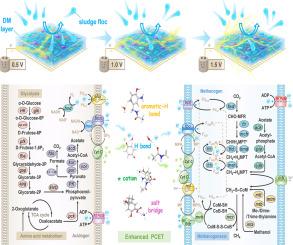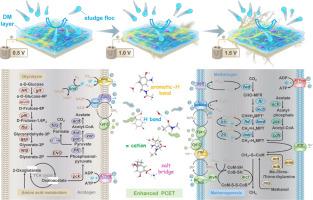强化污泥消化的电化学厌氧动态膜生物反应器:揭示分子相互作用和微生物机制
IF 12.4
1区 环境科学与生态学
Q1 ENGINEERING, ENVIRONMENTAL
引用次数: 0
摘要
本研究研究了逐级外加电压对电化学厌氧动态膜生物反应器(EC-AnDMBR)厌氧消化废活性污泥的影响。增加施加电压可显著减轻膜污染,降低跨膜压力增加速率,提高挥发性固体的消化和沼气产量。随着生物污染物质的减少,动态膜结构变得更加松散,这是由于在较高电压下污泥-膜相互作用能垒增加了42.6%。电化学分析表明厌氧污泥的电活性得到改善,电导率增加,内阻降低。氢/氘动力学同位素效应从616显著增加到25990,促进了质子耦合电子转移(PCET)途径。分子模拟结果表明,DOM中酰胺和醌基团富集,氢键和π-阳离子相互作用增强,这可能与PCET过程有关。此外,高电压促进了更确定性的微生物群落聚集,减少了上游微生物的迁移。有机代谢、电子/质子传递和甲烷生成中的基因上调进一步支持通过PCET途径提高消化性能。这些发现为ec -和mbr系统的分子机制和微生物生态学提供了有价值的见解,推动了更高效和可持续的污泥处理技术的发展。本文章由计算机程序翻译,如有差异,请以英文原文为准。


An electrochemical anaerobic dynamic membrane bioreactor for enhanced sludge digestion: Unveiling molecular interactions and microbial mechanisms
This study investigated the effects of stepwise external voltages on an electrochemical anaerobic dynamic membrane bioreactor (EC-AnDMBR) for anaerobic digestion of waste activated sludge. Increasing the applied voltage greatly mitigated membrane fouling, reduced the transmembrane pressure increase rate and enhanced both volatile solids digestion and biogas production. The dynamic membrane structure became looser with fewer biofouling substances, attributed to a 42.6 % increase in the sludge-membrane interaction energy barrier at higher voltages. Electrochemical analysis revealed improved electroactivity of the anaerobic sludge, as evidenced by increased conductivity and reduced internal resistance. The proton-coupled electron transfer (PCET) pathway was promoted, indicated by a significant increase in the hydrogen/deuterium kinetic isotope effect from 616 to 25,990. Molecular simulations of dissolved organic matter (DOM) showed an enrichment of amide and quinone groups, along with stronger hydrogen-bonding and π-cation interactions, which may contribute to the PCET process. Moreover, elevated voltages promoted more deterministic microbial community assembly and reduced upstream microbial immigration. Gene upregulation in organic metabolism, electron/proton transport, and methanogenesis further supported enhanced digestion performance via PCET pathway. These findings offer valuable insights into the molecular mechanisms and microbial ecology of EC-AnDMBR systems, advancing the development of more efficient and sustainable sludge treatment technologies.
求助全文
通过发布文献求助,成功后即可免费获取论文全文。
去求助
来源期刊

Water Research
环境科学-工程:环境
CiteScore
20.80
自引率
9.40%
发文量
1307
审稿时长
38 days
期刊介绍:
Water Research, along with its open access companion journal Water Research X, serves as a platform for publishing original research papers covering various aspects of the science and technology related to the anthropogenic water cycle, water quality, and its management worldwide. The audience targeted by the journal comprises biologists, chemical engineers, chemists, civil engineers, environmental engineers, limnologists, and microbiologists. The scope of the journal include:
•Treatment processes for water and wastewaters (municipal, agricultural, industrial, and on-site treatment), including resource recovery and residuals management;
•Urban hydrology including sewer systems, stormwater management, and green infrastructure;
•Drinking water treatment and distribution;
•Potable and non-potable water reuse;
•Sanitation, public health, and risk assessment;
•Anaerobic digestion, solid and hazardous waste management, including source characterization and the effects and control of leachates and gaseous emissions;
•Contaminants (chemical, microbial, anthropogenic particles such as nanoparticles or microplastics) and related water quality sensing, monitoring, fate, and assessment;
•Anthropogenic impacts on inland, tidal, coastal and urban waters, focusing on surface and ground waters, and point and non-point sources of pollution;
•Environmental restoration, linked to surface water, groundwater and groundwater remediation;
•Analysis of the interfaces between sediments and water, and between water and atmosphere, focusing specifically on anthropogenic impacts;
•Mathematical modelling, systems analysis, machine learning, and beneficial use of big data related to the anthropogenic water cycle;
•Socio-economic, policy, and regulations studies.
 求助内容:
求助内容: 应助结果提醒方式:
应助结果提醒方式:


